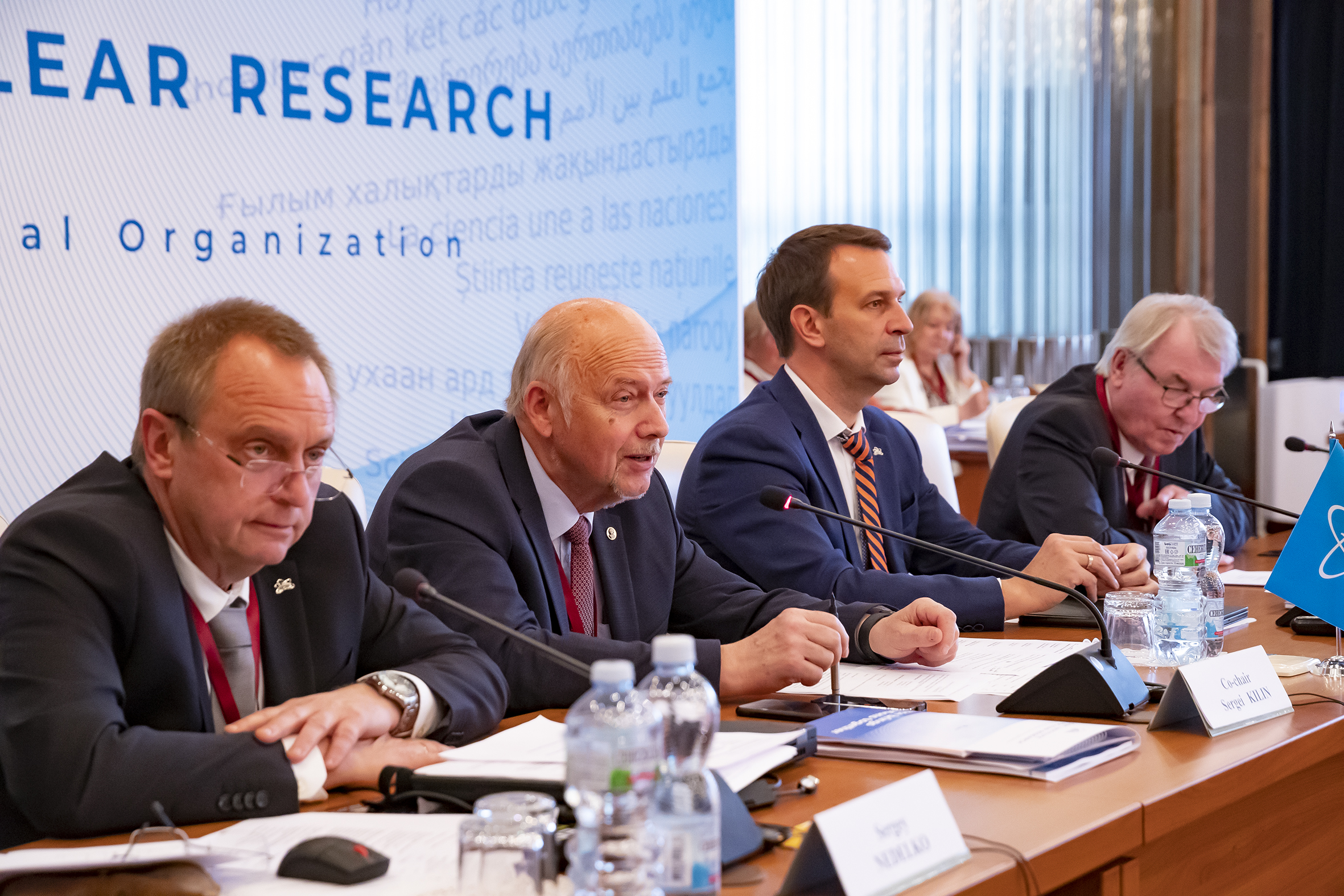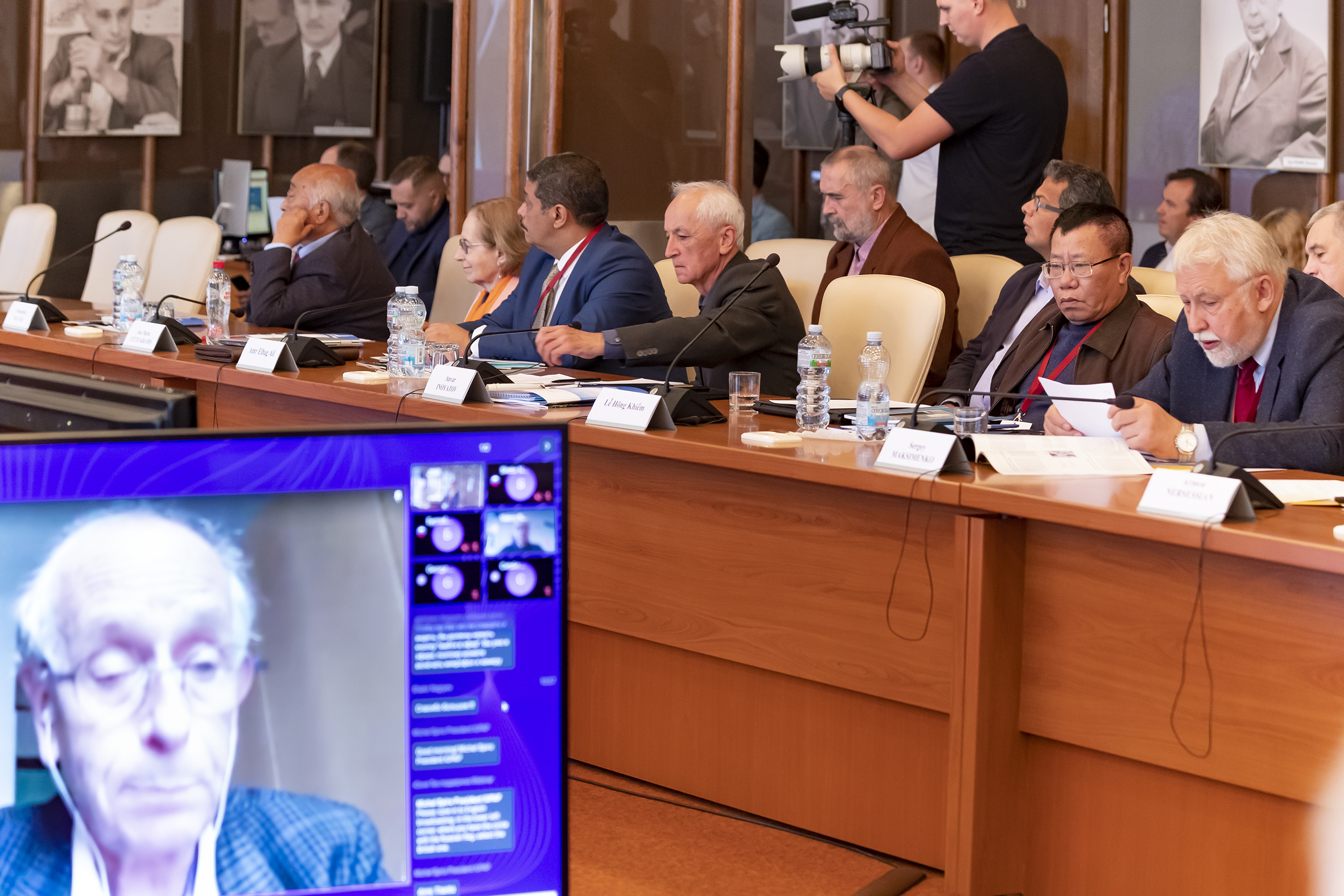Scientific Council: creating solid foundation for Institute’s development for next seven-year period
News, 21 September 2023
On 21 September 2023, the 134th session of the Scientific Council of the Joint Institute for Nuclear Research started. The members of the Scientific Council, international experts from leading scientific organizations and universities, considered the latest scientific results of JINR and the results of the summer meetings of PAC JINR, discussed the revised draft of the Seven-Year Plan for the Development of JINR for 2024–2030, held elections for the position of Director of DLNP at JINR, and approved the appointments of Deputy Directors of MLIT and FLNP. The event was co-chaired by the Academician of the National Academy of Sciences of Belarus, Professor Sergey Kilin.
The report by the Chairman of the Scientific Council, JINR Director and RAS Academician, Grigory Trubnikov, opened the programme of the session. The report was devoted to the resolutions adopted at the meeting of the Committee of Plenipotentiaries of the JINR Member States held in March 2023, the implementation progress of the current Seven-Year JINR Development Plan (2017-2023), and significant events in the scientific life of the Institute.
JINR Director noted the successful work of the MPD, BM@N, ARIADNA Collaborations of the NICA Megascience Project and the team of VBLHEP at JINR during the fourth commissioning run (September 2022 – March 2023), the longest in the history of the project.
A new Pu-227 isotope was discovered at the FLNR Superheavy Element Factory and the first alpha-, beta-, and gamma-spectroscopy experiment was conducted. Progress was made in the development of the DRIBs-III Accelerator Complex. The modernisation of the U-400M Cyclotron is close to the final stage. The first stage of construction works of the DC-140 Cyclotron has been completed, and the engineering networks for the construction of the U-400P Cyclotron have been prepared.
The JINR Multifunctional Information and Computing Complex is being developed at MLIT. During the latest modernisation of the Govorun Supercomputer, the overall peak performance of the supercomputer reached 1,7 petaflops with double precision. In 2023, the JINR Tier-1 Centre ranked second in the world in terms of productivity among other Tier-1 centres of the CMS experiment. The DIRAC distributed platform is used to support all fundamental experiments at NICA, as well as the Baikal-GVD Project. A digital ecosystem integrating services to support scientific, administrative, financial and economic activities, and to maintain the engineering and IT infrastructure of the Institute was launched at JINR.
“The main task and challenge for the next seven-year period is to engage qualified people from all over the world to work with all this unique infrastructure: detectors, accelerators, reactors,” JINR Director noted in his commentary.
The LINAC-200 Electron Accelerator is being prepared for commissioning at DLNP, which will be brought to an energy of 800 MeV and launched in 2-3 years. The megascience project of the Baikal-GVD Deep Underwater Neutrino Telescope continues to develop and has the status of the largest neutrino telescope in the Northern Hemisphere. JINR continues to participate in neutrino projects, both external and internal. Three experiments at the Kalinin Nuclear Power Plant, i.e. DANSS, νGeN, and Ricochet, are among them.
Based on the development of an inter-laboratory research programme at LRB, fundamental and applied research in life sciences and condensed matter physics is actively developing.
“I think that our very effective inter-laboratory cooperation is the scientific power of the Institute. When laboratories work together on one big task, such science and such experiments are powerful and highly effective,” Grigory Trubnikov stressed.
BLTP scientists obtained new results in the fields of elementary particle physics, atomic nucleus and condensed matter, as well as advanced mathematical physics.
The IBR-2 Reactor at FLNP has been prepared for the continuation of regular operation. Pending the receipt of new permits, the launch of the reactor is postponed approximately until the autumn of 2024. The concept of an intense ultracold neutron source and a neutron trap continues to be developed.
The Joint Institute continues to carry out joint work with CERN, in particular, in the NA64 experiment. JINR scientists are very active in the research and modernisation of the ATLAS, CMS, and ALICE detectors of the Large Hadron Collider.
As Grigory Trubnikov noted, the Institute continues to develop as an international organization. As part of the implementation of the cooperation agreement signed with Mexico in February this year, a major visit of JINR representatives to this country took place. A representative of Mexico Ana María Cetto, ex-president of the Mexican Physical Society, professor of the National Autonomous University of Mexico (UNAM) joined the Scientific Council and became its active participant. The Joint JINR–China Coordination Committee was established after signing the Protocol with the People’s Republic of China. Its first meeting dedicated to the elaboration of specific areas of cooperation was held in Dubna on 11 September. In addition, JINR representatives paid working visits to Vietnam, Pakistan, and India.
During the current seven-year period, JINR hosted 55 international conferences, 17 student schools. The number of publications in international journals exceeded 2,100 articles.
At the meeting, a member of the Scientific Council, President of the International Union of Theoretical and Applied Physics (IUPAP) Michel Spiro proposed to resume the joint school for young scientists of CERN and JINR. He plans to make this proposal at a meeting of the CERN Scientific Committee.
Grigory Trubnikov presented an updated draft of a new Seven-Year Plan for the Development of JINR for 2024 – 2030. In May-June of this year, a group of experts, led by JINR Scientific Leader, RAS Academician Victor Matveev, considered the text of the Seven-year programme. “We are grateful to the members of the Programme Advisory Committees and experts who discussed additional aspects at the PAC meetings, later included in the document, made comments and observations,” the JINR Director noted. In June-July, an additional assessment of the document concerning scientific research and the large research infrastructure of JINR was carried out. In August, additions to the projects of NICA, Baikal-GVD, etc. were made.
The work on changes in the Topical Plan for JINR Research and International Cooperation is in progress. Following the June meetings of the programme advisory committees, the PAC chairmen, Itzhak Tserruya, Valery Nesvizhevsky, and Dénes Lajos Nagy, presented proposals for the extension of existing topics and the opening of a number of new ones to the members of the Scientific Council.
The members of the Scientific Council noted the need to expand the areas of advanced research and development of JINR in beam and accelerators physics. The preparatory work carried out at the Institute to restructure the topical plan with the opening of the corresponding inter-laboratory topic was discussed. According to the SC members, all these actions create a firm foundation for the further development of the Institute in the new seven-year period.
The JINR Directorate proposed to include some topics and projects in a category “Major Research Infrastructure Projects”. The Baikal-GVD Neutrino Telescope and the development of the DRIBs-III Project at FLNR, which includes the construction of the U-400R Accelerator Complex and the development of experimental facilities for studying the chemical and physical properties of superheavy elements, were among them.
Participants of the event considered the opening of two new projects within the Nuclear Physics scientific direction until the end of 2028, namely “Investigation of heavy and superheavy elements” and “Light exotic nuclei at the borders of nuclear stability. They mainly aim to synthesise superheavy elements and study their nuclear and atomic (chemical) properties and the mechanisms of nuclear reactions.
Within the condensed matter physics direction, participants of the meeting discussed the opening of new projects “The new advanced neutron source at JINR” (the NEPTUN-3 Reactor), “Protection against physical and chemical stresses with tardigrade proteins (TARDISS)”, and “Nanobiophotonics”. The research programme of the latter is interdisciplinary and is aimed at both fundamental and applied research.
At the session, Makondelele Victor Tshivhase, appointed as the Director of iThemba LABS in 2023, was elected a new member of the Programme Advisory Committee for Nuclear Physics. Doctor Tshivhase is a nuclear scientist specializing in the study of radioactive contamination of water and soil, cancer risk mapping, and methods for removing radiation from the environment, who previously headed the Centre for Applied Radiation Science and Technology (CARST) at North-West University. He will replace Zeblon Vilakazi, a former member of the PAC NP from South Africa since 2009.
At the session of the Scientific Council, election and approval of candidates for the vacant positions in the directorates of the JINR laboratories took place. Thus, Evgeny Yakushev, Head of the DLNP Experimental Department of Nuclear Spectroscopy and Radiochemistry, Doctor of Physics and Mathematics, was elected new Director of the Laboratory of Nuclear Problems. The Scientific Council expressed gratitude to Vadim Bednyakov for his fruitful work as Director of the Laboratory since 2013.
The members of Scientific Council approved the positions of deputy directors of FLNP and MLIT. Yuri Kopach and Sergey Kulikov became Deputy Directors of the Frank Laboratory of Neutron Physics. Chuluunbaatar Ochbadrakh, Nikolay Voitishin, and Dmitry Podgainy became Deputy Directors of the Laboratory of Information Technologies.
Grigory Trubnikov announced vacant positions in the directorates of the JINR laboratories. In February 2024, at the 135th session of the JINR Scientific Council, its participants will elect the third DLNP Deputy Director. In September, at the 136th session, the members of the Scientific Council will elect the Director of the Laboratory of Radiation Biology. The Scientific Council has approved a proposal by the FLNP Directorate to open a position of the third vice director because of the extension of the Laboratory and the range of its research work. The election of the third FLNP deputy director will take place at the135th session of JINR SC.
The 134th session of the JINR Scientific Council will continue on 22 September.










